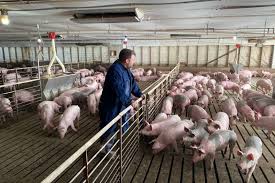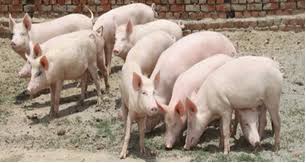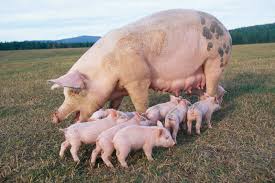Animal breeding is a branch of biological science that applies genetic principles to enhance farm animal production.
Essentially, it involves incorporating genes for desirable traits in animals that do not possess them, increasing the frequency of beneficial genes in populations where they already exist, and decreasing or eliminating genes responsible for undesirable traits.
This article explores the objectives of animal improvement programmes and the various selection methods used in breeding.
Animal Improvement Programmes in Agricultural Practices
Animal improvement programmes aim to produce animals with highly transmissible or heritable desirable traits and fewer undesirable characteristics. More specifically, animal improvement focuses on increasing productivity by breeding animals that yield more in terms of meat, milk, eggs, hair, and other products.
It also seeks to reduce the quality of certain animal products, such as the percentage of butterfat in milk, carotene content in egg yolks, carcass quality, egg shell color, and hatchability, while producing animals resistant to prevalent diseases.
Adaptability to environmental conditions is also a goal in some improvement programmes. Additionally, some programmes aim to breed stronger, more resilient work animals, or animals with lower mortality rates during growth and improved reproductive ability.
The production of animals with good mothering instincts is another focus of animal breeding. In some cases, breeders aim for faster growth rates and better feed conversion efficiency.
Some breeders may also focus on esthetic traits, such as producing polled cattle, colored milk, or eggs with a specific tint, or creating animals with proper physique for exhibition purposes.
Beyond improving desirable characteristics, breeding programmes also work to detect and eliminate undesirable traits, or reduce their occurrence in populations. Examples of such undesirable traits include dwarfism in cattle, crooked legs, and buck teeth in rabbits.
Improvement exercises can be carried out by introducing animals or semen from animals with desirable traits into existing stock, selecting individuals within the stock that exhibit more of the desirable traits, and mating such individuals to produce offspring with the desired characteristics.
Read Also: 6 Ways to Enhance Egg Production and Maximize Profits on Poultry
Selection Methods in Agricultural Animal Breeding

Selection refers to the non-random production of offspring from parent generations, or a situation where certain individuals in a population have an advantage over others in transmitting their genes to the next generation.
In random offspring production, all members of a generation mate at random to produce the next generation, maintaining equal gene frequencies. However, in non-random selection, gene frequencies in the next generation differ from the first generation, as genes determine animal performance.
Selection aims to increase the frequency of genes that contribute to desirable traits and reduce those that lead to undesirable traits.
Selection can be natural or artificial. Natural selection occurs when natural forces eliminate unfit individuals, favoring the fittest. Artificial selection, however, is a deliberate effort by humans to ensure the continued transmission of desirable traits or the removal of undesirable ones by allowing only animals with the desired traits to produce offspring.
Types of Artificial Selection in Animal Breeding
1. Individual Selection: This involves selecting animals for breeding based on their individual performance. It is most effective when heritability is high, meaning the observed variance in a trait is largely due to genetic factors. However, some traits are sex-limited, such as egg production and milk yield.
Highly heritable traits that can be measured in both sexes may not be easily improved through individual selection. It can also be used to eliminate undesirable recessive traits.
- 2. Family Selection: Family selection is based on the performance of an entire family. It is particularly useful when heritability is low, and environmental factors heavily influence phenotypic values.
In such cases, the average value of a family provides a better indication of genetic potential. Family selection is used when environmental effects are shared among family members and is more reliable with larger family sizes.
There are variations of family selection, including:
i. Sib Selection: Sib selection involves choosing individuals based on the performance of their siblings. The effectiveness of this method depends on factors such as the number of siblings, heritability of the trait, the genetic relationship between family members, and generation intervals. It is commonly used in poultry breeding, where generation intervals are shorter.
ii. Progeny Testing: In progeny testing, the offspring of an individual are evaluated to estimate the genetic value of the parent. This method is useful when heritability is low, the trait is sex-limited, or the trait can only be measured post-slaughter, such as loin eye in pigs or carcass weight.
Progeny testing is commonly used in beef cattle to select sires with desirable but moderately or weakly inherited traits.
iii. Within Family Selection: This method is applied when heritability is low and environmental factors are high within families. It assumes that the best-performing family member is genetically superior.
iv. Pedigree Selection: Pedigree selection involves choosing individuals based on their ancestors, particularly when little information is available about the individual due to age or sex. Pedigree records must provide sufficient and relevant data to be useful.
Read Also : How to Plant Fruit Trees for Optimum Performance
Factors Affecting the Effectiveness of Selection in Animal Breeding

1. Adequacy of Selection Criteria: The effectiveness of selection depends on how well the measured traits relate to the desired outcomes. For example, back fat thickness in pigs is an indicator of leanness and can serve as a selection criterion.
2. Heritability of the Trait: The progress made through selection is faster when the heritability of the trait is high. Conversely, progress is slower when heritability is low.
4. Intensity of Selection: The number of animals selected or discarded affects the effectiveness of selection. The greater the intensity, the faster the genetic progress.
4. Number of Traits Selected at a Time: Selection is more efficient when focusing on one trait at a time rather than multiple traits. However, it is often necessary to address correlated traits, such as egg size and egg weight, simultaneously.
5. Consistency of the Breeder: Consistency in the breeding programme, along with appropriate selection criteria and mating systems, increases the likelihood of success in animal improvement.
Animal improvement programmes aim to enhance desirable traits in animals while eliminating undesirable characteristics. These programmes utilize various selection methods, including individual, family, and progeny testing, to improve genetic traits in agricultural animals.
The effectiveness of these selection methods depends on factors such as heritability, selection intensity, and the consistency of the breeder’s approach.
Do you have any questions, suggestions, or contributions? If so, please feel free to use the comment box below to share your thoughts. We also encourage you to kindly share this information with others who might benefit from it. Since we can’t reach everyone at once, we truly appreciate your help in spreading the word. Thank you so much for your support and for sharing!

